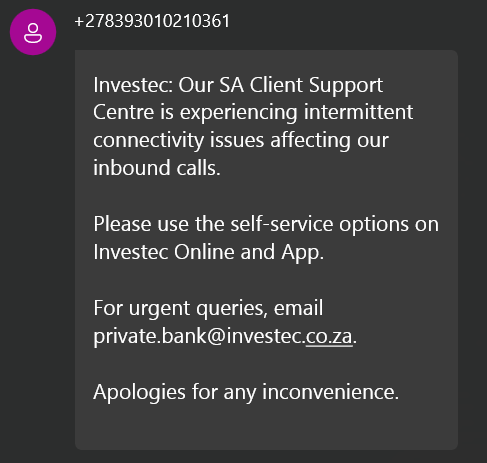📞Why Call Centres in Banking & Financial Services Need SD-WAN for Crystal-Clear Voice Quality🗣️
 Ronald Bartels
Ronald Bartels
In the financial services sector, where customer interactions are critical, the role of a call centre is paramount. Banks and institutions such as Investec and SARS (South African Revenue Service) handle high call volumes, and a single dropped call or poor voice quality can result in lost time, frustration, and even financial loss. Yet, despite their importance, call centres are often plagued by network connectivity issues, which directly impact voice quality. Recent outages, such as the one experienced by Investec Bank, highlight the need for more robust solutions, particularly SD-WAN.

Its not limited only to Investec, Discovery was also under the pump:

The Problem | Single Connectivity Providers
One of the fundamental errors in call centre connectivity is the reliance on a single service provider. Despite claims of high reliability and uptime, a single connection is inherently risky. Much like flying a jet with only one engine, the entire operation is at the mercy of that single point of failure. When it goes down, it results in significant downtime, poor customer service, and, as seen with SARS, endless frustration.
SARS has become infamous for dropped calls, with users often finding themselves starting their conversations over from the beginning after a sudden disconnection. It’s not just an inconvenience; it’s a clear indicator of a network architecture that lacks the necessary redundancy to ensure consistent service. The key to mitigating this risk is using multiple service providers, ensuring that if one connection falters, another can seamlessly take over. This is where SD-WAN proves invaluable.
SD-WAN | The Solution for Call Centre Connectivity
A Software-Defined Wide Area Network (SD-WAN) is purpose-built to manage multiple links simultaneously. By utilising a combination of fibre, fixed wireless access, and even 4G/LTE connections, SD-WAN ensures that voice traffic is always routed over the most reliable path. Should one link experience congestion, latency, or downtime, SD-WAN automatically redirects the traffic, ensuring calls continue without disruption.
SD-WAN is particularly suited for voice traffic in call centres because it offers:
Bandwidth Adaptation: SD-WAN monitors network conditions in real-time and adapts the bandwidth as needed. This ensures that voice calls always have sufficient resources, even when data traffic is competing for the same bandwidth.
Advanced Quality of Service (QoS): SD-WAN leverages Linux traffic control (tc), providing excellent bi-directional QoS. This means that both the outgoing and incoming voice packets are prioritised, resulting in clearer calls and reduced jitter or latency. Voice traffic is always prioritised over less time-sensitive traffic, ensuring a seamless customer experience.
Redundancy through Multiple Providers: The SD-WAN architecture ensures that you are not reliant on a single service provider. Using multiple last-mile connections, SD-WAN can distribute voice traffic across several networks, reducing the risk of outages. It’s akin to flying a jet with multiple engines; even if one engine fails, the others keep the flight smooth.
The Danger of Session-Based Firewalls for Voice
Another common mistake financial institutions make is relying on session-based firewalls for managing voice traffic. Firewalls that track sessions often struggle with the nature of voice communications, which involve many small packets being sent in real time. Session-based firewalls can drop or delay these packets, leading to poor call quality or even dropped calls. In contrast, SD-WAN, using packet-based prioritisation, is much better suited for handling the real-time requirements of voice over IP (VoIP).
Eish, session-based firewalls and voice simply don’t mix. VoIP traffic needs a more flexible approach, and SD-WAN provides that by focusing on packet-level management rather than sessions. This allows for better handling of voice streams, improving call clarity and reducing latency issues.
Time for a Change in South Africa
It’s time for South African banks, financial services, and the tax authorities to seriously reconsider their call centre infrastructure. As highlighted by the Investec outage and the ongoing issues with SARS, relying on a single connectivity provider or outdated network architectures is no longer acceptable. These institutions must implement proper SD-WAN solutions, which not only improve voice quality but also offer the redundancy and flexibility required in today’s demanding call centre environments.
The Sweet Spot | SD-WAN in Call Centres
The sweet spot for SD-WAN in call centres lies in its ability to:
Mitigate risk by utilising multiple last-mile links from different providers.
Optimise voice traffic through advanced QoS and bandwidth management.
Ensure reliability through dynamic link failover, ensuring no call is dropped due to connectivity issues.
By implementing a robust SD-WAN solution, financial institutions in South Africa can ensure that their call centres operate with crystal-clear voice quality, providing the level of customer service that their clients expect. SD-WAN is not just a technical upgrade; it’s a business necessity for staying competitive in today’s fast-paced, customer-centric world.
Ronald Bartels ensures that Internet inhabiting things are connected reliably online at Fusion Broadband South Africa - the leading specialized SD-WAN Last Mile provider in South Africa. Learn more about the best SD-WAN in the world: 👉Contact Fusion✈️
Subscribe to my newsletter
Read articles from Ronald Bartels directly inside your inbox. Subscribe to the newsletter, and don't miss out.
Written by

Ronald Bartels
Ronald Bartels
Driving SD-WAN Adoption in South Africa